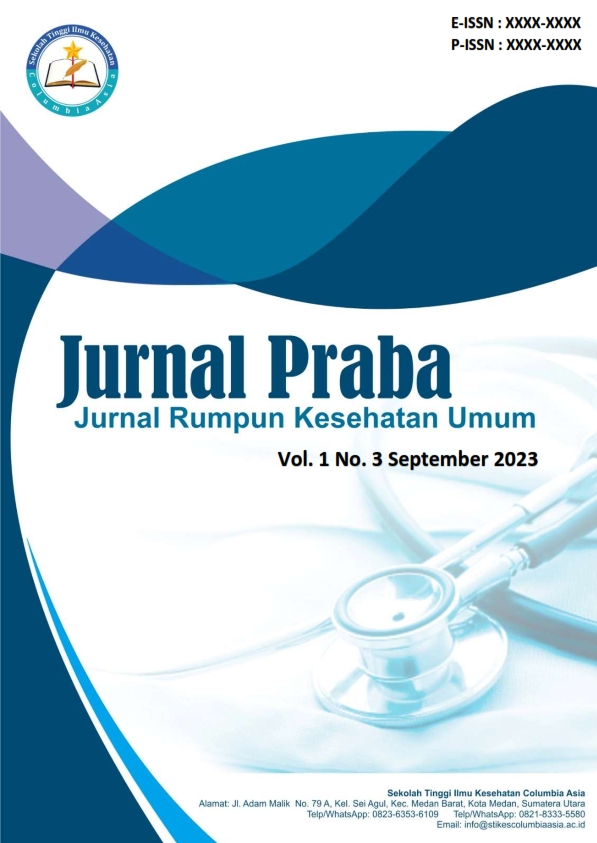Implementasi Latihan Genggam Bola Karet Pada Asuhan Keperawatan Pasien Stroke Dengan Gangguan Mobilitas Fisik Pada Ny. R Untuk Meningkatkan Kekuatan Massa Otot Di Wilayah Kerja Puskesmas Medan Sunggal
DOI:
https://doi.org/10.62027/praba.v3i3.549Keywords:
Impaired Physical Mobility, Holding a Rubber Ball, StrokeAbstract
Stroke is a major neurological disease that occurs in adults and the elderly, based on the high number of emergencies and the main cause of disability and death. The most common disorder in stroke is weakness or deficits in the musculoskeletal system such as parese or plegia. These conditions will cause various disorders in patients such as decreased muscle tone and strength, muscle weakness which if not treated immediately will lead to contractures, which ultimately cause impaired mobilization. Impaired fulfillment of daily activities and disability. Nursing actions to overcome physical mobility disorders are muscle strengthening exercises, especially in the upper extremities by holding a rubber ball. Purpose: Help solve the problem of physical mobility disorders to increase muscle strength in stroke patients with rubber ball grasping exercises. Methods: By collecting data from interviews and observations using case studies and subjects in stroke patients with nursing problems. Results: After performing the exercise of grasping a rubber ball for 2 times in 7 days there is an increase in muscle strength with a muscle strength value of 1/5 to 3/5. Conclusion: The action of grasping rubber ball exercises can increase muscle strength to overcome physical mobility disorders in stroke patients
References
Ambarwati, E., & Dewi Listiyanawati, M. (2024). Application of Rubber Ball Grasping Therapy To Increase Muscle Strength in Non-Hemorrhagic Stroke Patients. 43.
Azizah, N., & Wahyuningsih, W. (2020). Genggam Bola Untuk Mengatasi Hambatan Mobilitas Fisik Pada Pasien Stroke Non Hemoragik. Jurnal Manajemen Asuhan Keperawatan, 4(1), 35–42. https://doi.org/10.33655/mak.v4i1.80.
Kuriakose, D., & Xiao, Z. (2020). Pathophysiologi and treament of stroke: Present Status and Future Perspectives . International Journal of Molecular Sciences, 21(20), 1–24.
Kusumaningrum, A. L., Wulandari, T. S., & Parmilah. (2023). Upaya Penyelesaian Masalah Keperawatan Gangguan Mobilitas Fisik pada Pasien Stroke dengan Teknik Latihan Penguatan Otot Menggenggam Bola Karet. Jurnal Ilmiah Keperawatan Dan Kesehatan Alkautsar (JIKKA), 2(2), 1–10.
Muna, N. (2024). Peningkatan kekuatan otot pada pasien stroke non hemoragik melalui kombinasi latihan range of motion dan latihan genggaman bola karet : Studi kasus asuhan keperawatan. 1(3), 1–8.
Ningsih, M. U., Nurunniswati, Mas’adah, Cembun, Sentana Dwi, A., & Mardiatun. (2022). Pendidikan Kesehatan Tentang Latihan ROM (Range of Motion) Meningkatkan Pengetahuan dan Keterampilan Keluarga Penderita Stroke. Bima Nursing Journal, 4(1), 24–31. http://jkp.poltekkes-mataram.ac.id/index.php/bnj/article/view/1044.
Pamungkasty, M., & Dewi, E. (2020). Literatur Review: Analisis Penanganan Stroke Iskemik di Instalasi Gawat Darurat Tahun 2016-2020. Stroke, 51(3), 1025–1026.
Puskesmas Medan Sunggal. (2023). Profil Puskesmas Medan Sunggal.
Putra Kusuma, A., Tri Utami, I., & Purwono, J. (2022). Pengaruh Terapi “Menggengam Bola Karet Bergerigi” Terhadap Perubahan Kekuatan Otot Pada Pasien Stroke Diukur Menggunakan Hangryp Dynamometer Di Ruang Syaraf Rsud Jend a Yani Kota Metro. Jurnal Cendikia Muda, 2(1), 17–23. https://journal.uny.ac.id/index.php/jpts/article/view/53930.
PPNI (2017). Standar Diagnosis Keperawatan Indonesia, Edisi 1. Jakarta: DPP-PPNI
PPNI (2017). Standar Intervensi Keperawatan Indonesia, Edisi 1. Jakarta: DPP-PPNI
PPNI (2017). Standar Luaran Keperawatan Indonesia, Edisi 1. Jakarta: DPP-PPNI
Ramayanti, D. E & Etika, N. A. (2022). Pelatihan Terapi ROM (Range Of Motion) Pada Lansia Dengan Riwayat Stroke di Desa Bujel Kota Kediri. Jurnal Pengabdian Kepada Masyarakat. e-ISSN : 2721-9135. Vol.3 No 4, 2022, PP. 1085.
Riskesdas. (2018). Laporan Nasional Riskesdas. Badan penelitian dan pengembangan kesehatan.
Riskesdas. (2018). Laporan Provinsi Sumatera Utara. Badan penelitian dan pengembangan kesehatan.
Saputra, D. G., Dewi, N. R., & Ayubana, S. (2022). Penerapan Terapi Menggenggam Bola Karet Terhadap Perubahan Kekuatan Otot Pada Pasien Stroke Dengan Hemiparase Di Kota Metro. Jurnal Cendikia Muda, 2(September), 308–312.
Setiawan et al. (2021). Diagnosis Dan Tatalaksana Stroke Hemoragik. Jurnal Medika Utama, 02(01), 402–406.
Siswanti Heny, Dewi, H., & Susanti, H. D. (2021). Pengaruh Latihan Menggenggam Bola Karet Terhadap Kekuatan Otot Pasien Stroke Non Hemoragik. University Research Colloqium 2021, 1, 806–809.
Tamburian, A. G., Ratag, B. T., & Nelwan, J. E. (2020). Hubungan antara Hipertensi, Diabetes Melitus, dan Hiperkolesterolemia dengan Kejadian Stroke Iskemik. Journal of Public Health and Community Medicine, 1(1), 27–33.
Togu, G. M., Lisda Amalia, & Trully Deti Rose Sitorus. (2021). Pola Pengobatan Stroke Iskemik Pada Pasien Lansia di Rumah Sakit Hasan Sadikin Bandung. Journal Of The Indonesian Medical Association, 71(2), 65–70. https://doi.org/10.47830/jinma-vol.71.2-2021-387.
WHO (World Health Organization). (2022). Global Stroke Fact Sheet 2022 Purpose : Data Sources : World Health Organization.
Widyanto, E. P., Maisyaroh, A., & Kurnianto, S. (2022). Simulasi Kasus Sebagai Upaya Deteksi Dini Dan Tatalaksana Awal Kegawatdaruratan Pada Serangan Stroke. 1.
Downloads
Published
How to Cite
Issue
Section
License
Copyright (c) 2025 Jurnal Praba : Jurnal Rumpun Kesehatan Umum

This work is licensed under a Creative Commons Attribution-ShareAlike 4.0 International License.







